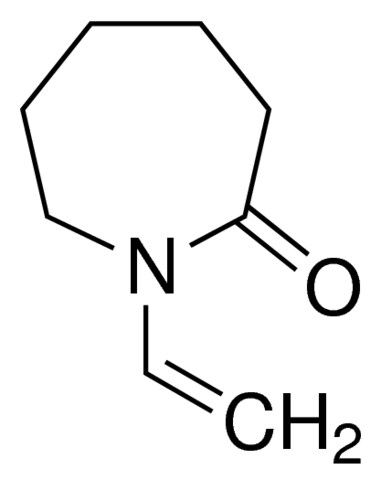N-Vinylcaprolactam CAS#: 2235-00-9; ChemWhat Code: 24514
Identification
| Product Name | N-Vinylcaprolactam |
| IUPAC Name | 1-ethenylazepan-2-one |
| Molecular Structure |  |
| CAS Registry Number | 2235-00-9 |
| EINECS Number | 218-787-6 |
| MDL Number | MFCD00080693 |
| Beilstein Registry Number | No data available |
| Synonyms | 1-ethenylazepan-2-one;1-Ethenylhexahydro-2H-azepin-2-one;1-Vinyl-2-azepanon;1-Vinyl-2-azepanone;1-Vinyl-2-azépanone;1-Vinylazepan-2-one |
| Molecular Formula | C8H13NO |
| Molecular Weight | 139.195 |
| InChI | InChI=1S/C8H13NO/c1-2-9-7-5-3-4-6-8(9)10/h2H,1,3-7H2 |
| InChI Key | JWYVGKFDLWWQJX-UHFFFAOYSA-N |
| Canonical SMILES | C=CN1CCCCCC1=O |
| Patent Information | ||
| Patent ID | Title | Publication Date |
| US2010/40572 | BLOCK ETHYLENIC COPOLYMERS COMPRISING A VINYLLACTAM BLOCK, COSMETIC COMPOSITIONS CONTAINING THEM AND COSMETIC USE OF THESE COPOLYMERS | 2010 |
| US2009/131657 | PROCESS FOR ALKENYLATING CARBOXAMIDES | 2009 |
Physical Data
| Appearance | Colorless transparent liquid |
| Solubility | No data available |
| Flash Point | 112.5±9.4 °C |
| Refractive index | 42.1±0.3 cm3 |
| Sensitivity | No data available |
| Melting Point, °C | Solvent (Melting Point) |
| 34 – 35 |
| Boiling Point, °C | Pressure (Boiling Point), Torr |
| 95 | 11 |
| 128 | 21 |
| 129 – 130 | 20.5 |
| 95 – 95.5 | 4 |
| Refractive Index | Wavelength (Refractive Index), nm | Temperature (Refractive Index), °C |
| 1.511 | 589 | 20 |
| 1.5135 | 589 | 20 |
| 1.5051 | 589 | 40 |
| Density, g·cm-3 | Reference Temperature, °C | Measurement Temperature, °C |
| 1.0287 | 4 | 20 |
| 1.0084 | 4 | 40 |
| Description (Association (MCS)) | Comment (Association (MCS)) |
| Association with compound | Phenol, Assoziationskonst. k(ass) |
Spectra
| Description (NMR Spectroscopy) | Nucleus (NMR Spectroscopy) | Solvents (NMR Spectroscopy) | Temperature (NMR Spectroscopy), °C | Frequency (NMR Spectroscopy), MHz |
| Chemical shifts, Spectrum | 1H | benzene-d6 | 26.84 | 300 |
| Chemical shifts, Spectrum | 13C | benzene-d6 | 26.84 | 75.6 |
| Chemical shifts | 1H | water-d2 | ||
| Chemical shifts | 13C | CDCl3 | ||
| Spin-spin coupling constants | CDCl3 |
| Description (IR Spectroscopy) | Solvent (IR Spectroscopy) | Comment (IR Spectroscopy) |
| Bands, Spectrum | potassium bromide | |
| Bands | KBr | 1645 – 1620 cm**(-1) |
| Description (Mass Spectrometry) |
| high resolution mass spectrometry (HRMS), electron impact (EI), spectrum |
| LCMS (Liquid chromatography mass spectrometry), TOFMS (Time of flight mass spectrum), Spectrum |
| spectrum |
| Description (UV/VIS Spectroscopy) | Solvent (UV/VIS Spectroscopy) | Comment (UV/VIS Spectroscopy) | Absorption Maxima (UV/VIS), nm | Ext./Abs. Coefficient, l·mol-1cm-1 |
| Absorption maxima | cyclohexane | 235 | 23000 | |
| UV/VIS | ||||
| Spectrum | heptane | 230 – 270 nm |
Route of Synthesis (ROS)
| Conditions | Yield |
| With indium(III) chloride In water for 0.166667h; Diels-Alder reaction; Reflux; diastereoselective reaction; | 92% |
| With polyaniline-iodine In neat (no solvent) at 80℃; for 0.166667h; Green chemistry; | 92% |
| With iron oxide nanoparticles with Saururus chinensis (S. chinensis) leaf extract (IONPs) In acetonitrile for 4h; Reflux; Green chemistry; | 91% |
| With antimony(III) chloride In acetonitrile at 25℃; for 1.25h; Diels-Alder reaction; diastereoselective reaction; | 85% |
| With iron(III) chloride In acetonitrile for 10h; imino Diels-Alder reaction; Reflux; | 80% |
Safety and Hazards
| Pictogram(s) |   |
| Signal | Danger |
| GHS Hazard Statements | H302 (98.29%): Harmful if swallowed [Warning Acute toxicity, oral] H312 (48.72%): Harmful in contact with skin [Warning Acute toxicity, dermal] H317 (80.34%): May cause an allergic skin reaction [Warning Sensitization, Skin] H319 (92.02%): Causes serious eye irritation [Warning Serious eye damage/eye irritation] H335 (12.54%): May cause respiratory irritation [Warning Specific target organ toxicity, single exposure; Respiratory tract irritation] H372 (75.21%): Causes damage to organs through prolonged or repeated exposure [Danger Specific target organ toxicity, repeated exposure] H373 (10.83%): Causes damage to organs through prolonged or repeated exposure [Warning Specific target organ toxicity, repeated exposure] Information may vary between notifications depending on impurities, additives, and other factors. |
| Precautionary Statement Codes | P260, P261, P264, P270, P271, P272, P280, P301+P312, P302+P352, P304+P340, P305+P351+P338, P312, P314, P321, P322, P330, P333+P313, P337+P313, P363, P403+P233, P405, and P501 (The corresponding statement to each P-code can be found at the GHS Classification page.) |
Other Data
| Transportation | Under the room temperature and away from light |
| HS Code | No data available |
| Storage | Under the room temperature and away from light |
| Shelf Life | 2 years |
| Market Price | USD |
| Druglikeness | |
| Lipinski rules component | |
| Molecular Weight | 139.197 |
| logP | 0.999 |
| HBA | 2 |
| HBD | 0 |
| Matching Lipinski Rules | 4 |
| Veber rules component | |
| Polar Surface Area (PSA) | 20.31 |
| Rotatable Bond (RotB) | 1 |
| Matching Veber Rules | 2 |
| Use Pattern |
| N-Vinylcaprolactam CAS#: 2235-00-9 Comonomer in an injectable bone cement to treat porous bone |
| N-Vinylcaprolactam CAS#: 2235-00-9 Fixation of cancellous bone |
| N-Vinylcaprolactam CAS#: 2235-00-9 Fixation of osteoporotic bone |
| Bone cement |
Buy Reagent | |
| No reagent supplier? | Send quick inquiry to ChemWhat |
| Want to be listed here as a reagent supplier? (Paid service) | Click here to contact ChemWhat |
Approved Manufacturers | |
| Warshel Chemical Ltd | http://www.warshel.com/ |
| Want to be listed as an approved manufacturer (Requires approvement)? | Please download and fill out this form and send back to approved-manufacturers@chemwhat.com |
Contact Us for Other Help | |
| Contact us for other information or services | Click here to contact ChemWhat |

